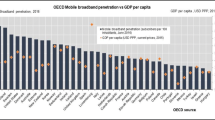Abstract
This paper examines the shifting influence of household characteristics and telecommunications infrastructure on the residential broadband adoption decision for Oklahoma residents between 2003 and 2006. In particular, the spread of wired telecommunications infrastructure (namely cable Internet and Digital Subscriber Lines (DSL)) is examined, along with the effect that this diffusion has had on broadband access rates. The data indicates that the gap in broadband access rates between rural and urban areas has remained relatively constant over this period despite increased levels of cable and DSL throughout the state. In addition, an inter-temporal decomposition shows that the increasing levels of infrastructure are not the dominant cause of higher broadband rates over time. Instead, shifting returns to specific characteristics (namely income) are found to be the primary contributors.
Similar content being viewed by others
References
Armstrong B (2005) DSL services available to all Oklahoma Residents by 2007. J Rec December 15, 2005
Aron D, Burnstein D (2003) Broadband adoption in the United States: an empirical analysis. In: Shampine A (ed) Down to the wire: studies in the diffusion and regulation of telecommunication technologies
Associated Press (2007) Oil and gas industry lifts Oklahoma economy. 28 March 2007
Blinder A (1973) Wage discrimination: reduced form and structural variables. J Human Resourc 8: 436–455
Byers A (2006) Communities address technology-related development. Tangents: technologies across Nebraska Newsletter, Winter 2006
Carter R (2003) SBC begins $300 million Internet service expansion. J Rec 30 April 2003
Coleman B (2004) Minnesota project promotes broadband. Tangents: technologies across Nebraska Newsletter, Summer 2004
Cooper M, Kimmelman G (1999) The digital divide confronts the telecommunications act of 1996. Consumer Federation of America, Washington, DC
Denni M, Gruber H (2005) The diffusion of broadband telecommunications: the role of competition. Working Paper. http://ssrn.com/abstract=82950. Downloaded 4 Jan. 2007
Fairlie R (2003) An extension of the Blinder-Oaxaca decomposition technique to logit and probit models. Paper Number 873, Economic Growth Center, Yale University
Federal Communications Commission—Industry Analysis and Technology Division (2006) High-speed Service for Internet Access: Status as of June 30, 2006. http://www.fcc.gov/wcb/iatd/comp.html. Downloaded 3 Oct. 2007
Flamm K, Chaudhuri A (2007) An analysis of the determinants of broadband access. Telecommun Policy 31: 312–326
Glasmeier A, Wood L (2003) Broadband Internet service in rural and urban Pennsylvania: a commonwealth or digital divide? Report generated for the Center for Rural Pennsylvania. http://www.ruralpa.org/broadband_report.pdf. Downloaded 1 May 2007
Government Accountability Office (2006) Broadband deployment is extensive throughout the United States, but it is difficult to assess the extent of deployment gaps in rural areas. Report to Congressional Committees GAO-06-426. http://www.gao.gov/cgi-bin/getrpt?GAO-06-426. Downloaded 11 May 2006
Grubesic T (2003) Inequities in the broadband revolution. Ann Reg Sci 37: 263–289
Hall R, Lehr W (2002) Promoting broadband investment and avoiding monopoly. http://www.sandhillecon.com/
Horrigan J (2005) Broadband adoption at home in the United States: growing but slowing. PEW Internet and American Life Project, Washington, DC
Horrigan J (2005) Rural broadband Internet use. PEW Internet and American Life Project, Washington, DC
Horrigan J (2006) Home broadband adoption 2006. PEW Internet and American Life Project, Washington, DC
Horrigan J (2007) Home broadband adoption 2007. PEW Internet and American Life Project, Washington, DC
Horrigan J (2007) Why it will be hard to close the broadband divide. PEW Internet and American Life Project, Washington, DC
Le A, Miller P (2004) Inter-temporal decompositions of labour market and social outcomes. Australian Econ Papers, March 10–20
Mills B, Whitacre B (2003) Understanding the metropolitan – non-metropolitan digital divide. Growth Change 34(2): 219–244
National Cable and Telecommunications Association (2004) Industry overview. http://www.ncta.com/Docs/pagecontent.cfm?pageID=96. Downloaded 2 Oct. 2007
National Exchange Carrier Association (2006) Trends 2006: making progress with broadband. Whippany, NJ. http://www.neca.org/media/trends_brochure_website.pdf. Downloaded 20 June 2007
National Telecommunications and Information Administration (NTIA) and Economics Statistics Administration (2002) How Americans Are expanding their use of the Internet. US Department of Commerce, Washington, DC
Oaxaca R (1973) Male–female differentials in urban labor markets. Int Econ Rev 14: 693–709
Page D (2006) Oklahoma’s oil and gas economy has doubled. J Rec (Oklahoma City), 4 May 2006
Prentice R (1976) A generalization of the probit and logit methods for dose–response curves. Biometrics 32: 761–768
Rogers E (2003) Diffusion of innovations, 5th edn. Free Press, New York
Rogers E, Shoemaker F (1971) Communication of innovations: a cross-cultural approach, 2nd edn. Free Press, New York
Rose R (2003) Oxford Internet survey results. The Oxford Internet Institute, The University of Oxford, UK
Strover S (2001) Rural Internet connectivity. Telecommun Policy 25: 331–347
Strover S (2003) The prospects for broadband deployment in rural America. GovernmentInform Quart 20: 95–106
Tarde G (1903) The laws of imitation. Translated by E.C. Parsons with introduction by F. Giddings, Henry, Holt and Co., New York
Whitacre B, Mills B (2007) Infrastructure and the rural – urban divide in high-speed residential Internet access. Int Reg Sci Rev 30(3): 249–273
Author information
Authors and Affiliations
Corresponding author
Rights and permissions
About this article
Cite this article
Whitacre, B.E. Factors influencing the temporal diffusion of broadband adoption: evidence from Oklahoma. Ann Reg Sci 42, 661–679 (2008). https://doi.org/10.1007/s00168-007-0178-7
Received:
Accepted:
Published:
Issue Date:
DOI: https://doi.org/10.1007/s00168-007-0178-7




